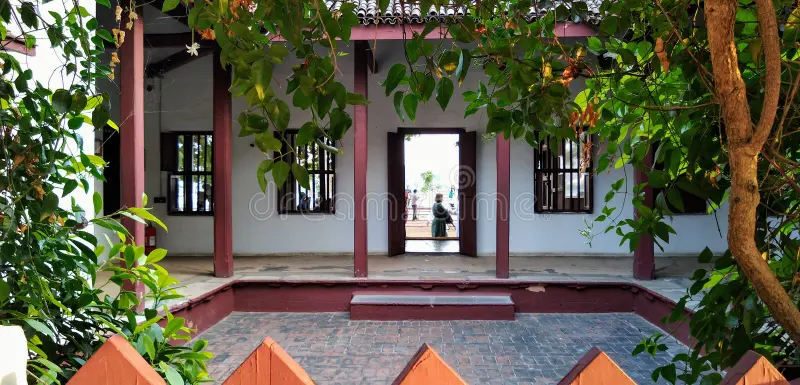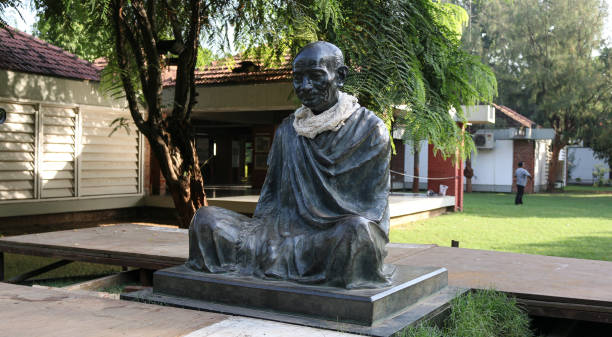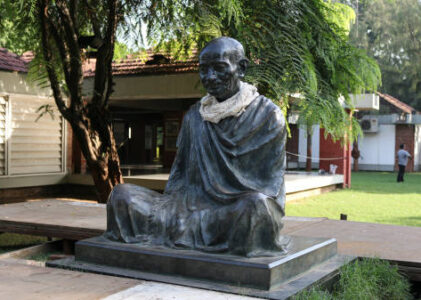Introduction
Sabarmati Ashram, located on the banks of the Sabarmati River in Ahmedabad, Gujarat, is one of the most significant sites in India’s struggle for independence. Founded by Mahatma Gandhi in 1917, this ashram served as a base for his non-violent movement against British colonial rule. Today, it stands as a testament to Gandhi’s teachings, principles, and enduring legacy. This comprehensive guide explores the history, architecture, activities, and the philosophical essence of Sabarmati Ashram.

Historical Background
Origins of the Ashram
Sabarmati Ashram was established in 1917 as the Satyagraha Ashram. Gandhi and his followers aimed to create a space for spiritual and political education. The choice of location was strategic, as it provided a serene environment for contemplation and planning.
Role in the Freedom Movement
The ashram became a hub for numerous pivotal movements, including the Salt March in 1930. Gandhi’s non-violent philosophy gained traction here, inspiring countless Indians to join the freedom struggle. It was not just a residence; it became a center for mobilizing the masses.
Post-Independence Significance
After India gained independence in 1947, the ashram continued to be a symbol of peace and non-violence. It serves as a pilgrimage site for people across the globe who wish to pay homage to Gandhi’s principles.
Architecture of Sabarmati Ashram
Overview of Design
The architectural style of Sabarmati Ashram reflects simplicity and functionality, aligning with Gandhi’s principles of minimalism. The buildings are constructed with local materials, showcasing traditional Indian architecture.
Key Structures
Bungalow of Mahatma Gandhi
The main residence of Gandhi, this modest bungalow has been preserved as it was during his time. The simplicity of the living quarters is a testament to his belief in leading a life devoid of excess.
Museum and Exhibits
The ashram houses a museum that displays photographs, letters, and artifacts related to Gandhi’s life and the Indian freedom movement. The exhibits are organized chronologically, providing visitors with a comprehensive understanding of his journey.
Library
The ashram features a library filled with books on Gandhian philosophy, Indian history, and literature. It serves as a resource for scholars and visitors interested in Gandhi’s ideologies.
Natural Surroundings
The ashram is surrounded by lush greenery and the gentle flow of the Sabarmati River. The serene environment enhances the spiritual experience, inviting reflection and contemplation.

Life at Sabarmati Ashram
Daily Routine of Gandhi
Gandhi’s daily life at the ashram was structured around simplicity and discipline. He emphasized self-reliance and communal living, engaging in spinning, farming, and meditation.
Community Living
The ashram operated on communal principles where residents shared responsibilities, resources, and labor. This model of living was essential in fostering unity and cooperation among followers.
Spiritual Practices
Gandhi encouraged practices such as prayer, meditation, and self-reflection. These spiritual activities were integral to his philosophy and helped maintain mental clarity amidst the chaos of the freedom struggle.
Philosophy and Teachings
Non-violence (Ahimsa)
At the core of Gandhi’s teachings is the principle of non-violence, or Ahimsa. This philosophy became the foundation of the Indian independence movement and continues to inspire movements for peace and justice worldwide.
Truth (Satya)
Gandhi emphasized the importance of truth in all aspects of life. He believed that living truthfully is essential for personal integrity and societal harmony.
Simple Living, High Thinking
Gandhi advocated for a simple lifestyle, arguing that material possessions could lead to moral degradation. He practiced and promoted minimalism, emphasizing the value of inner richness over material wealth.
Activities and Events
Guided Tours
Visitors to Sabarmati Ashram can participate in guided tours that provide insights into Gandhi’s life, teachings, and the ashram’s historical significance. Knowledgeable guides share stories and anecdotes that enrich the experience.
Workshops and Educational Programs
The ashram organizes workshops focusing on Gandhian philosophy, sustainable living, and social justice. These programs are designed to inspire individuals to apply Gandhi’s teachings in contemporary contexts.
Annual Events
Sabarmati Ashram hosts various events commemorating important dates related to Gandhi’s life, including his birth anniversary on October 2nd. These celebrations often feature cultural programs, lectures, and discussions on his teachings.
Visiting Sabarmati Ashram
How to Reach
By Air
The nearest airport is Sardar Vallabhbhai Patel International Airport in Ahmedabad, approximately 15 kilometers from the ashram. Regular flights connect it to major cities across India.
By Train
Ahmedabad Railway Station is well-connected to various cities in India. From the station, visitors can hire taxis or take public transport to reach the ashram.
By Road
The ashram is easily accessible by road, with well-maintained highways connecting it to key locations in Ahmedabad. Local buses and auto-rickshaws are also available for convenient transportation.
Entry Fees and Timings
Sabarmati Ashram is open to visitors from 8:30 AM to 6:30 PM, and there is no entry fee. However, donations are welcome to support the ashram’s initiatives.
Best Time to Visit
The ideal time to visit Sabarmati Ashram is between October and March, when the weather is pleasant. The ashram’s lush surroundings and serene atmosphere enhance the overall experience.

Accommodation Near Sabarmati Ashram
Hotels and Guesthouses
Several hotels and guesthouses are located near Sabarmati Ashram, catering to different budgets. Options range from luxury hotels to budget accommodations.
Homestays
For a more authentic experience, visitors can opt for homestays in the surrounding areas. This allows guests to interact with locals and gain insights into their daily lives.
Dining Options
Numerous eateries near the ashram offer a variety of cuisines, including traditional Gujarati dishes. Visitors can indulge in local flavors and experience the culinary culture of Ahmedabad.
The Legacy of Sabarmati Ashram
Influence on Future Leaders
Gandhi’s teachings and the principles practiced at Sabarmati Ashram have influenced countless leaders and movements worldwide. Figures like Martin Luther King Jr. and Nelson Mandela drew inspiration from Gandhi’s philosophy of non-violence.
Preservation of Gandhi’s Legacy
Sabarmati Ashram plays a crucial role in preserving Gandhi’s legacy. It serves as a research center, a museum, and a space for dialogue on issues related to peace, justice, and human rights.
Global Significance
The ashram attracts visitors from around the world, symbolizing the universal quest for peace and justice. It stands as a reminder of the power of non-violent resistance in the face of oppression.
Conclusion
Sabarmati Ashram is more than just a historical site; it is a living testament to the enduring spirit of Mahatma Gandhi and his principles of non-violence, truth, and simple living. Visiting the ashram offers a profound experience, allowing individuals to connect with Gandhi’s legacy and reflect on their own values and beliefs. Whether you seek spiritual solace, historical knowledge, or inspiration for social change, Sabarmati Ashram promises a transformative experience.
For more information and planning your visit, check out the official Sabarmati Ashram website.
Internal Link:
Top Tourist Destinations in India: A Complete Travel Guide
Explore India’s Rich Culture and Tourism Wonders

